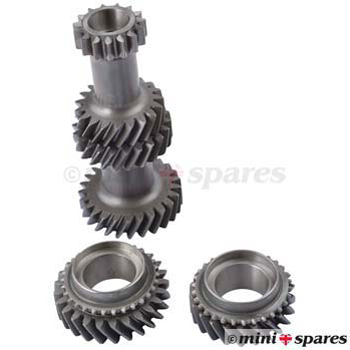Development
During 1985 which was nearly 25 years after the original four star wheel mini concept, the idea was applied to rear wheel drive applications when David Hiron was approached by British trial car champion Julian Fack to solve the problem of persistent diff. Read more
Over the last few years we have developed this gear kit to be the ultimate for the rod change gearbox! Although there are many advantages to using a straight cut gears, often their disadvantages outweigh the advantages....
Read more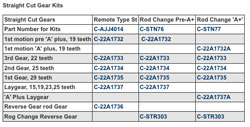
Table of straight cut gear sets. Read more
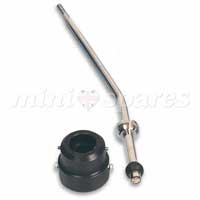
REMOTE CHANGE
Remove original gearstick. Fit Quickstick with original plastic collar, spring and spring retainer, grease well and refit with new spacer. Place flange downwards using longer 5/16” UNC capscrews. Read more

Every effort has been made in the production of this pin to ensure its maximum specification with regard to material, heat treatment, and finish ground size.
The planet wheels to be used should be checked on the pin prior to assembly to ensure a reasonable tolerance. If excessive play is evident, select different planet wheels.
Due to excessive manufacturing tolerances, it should not be assumed that new planet wheels will be okay. Selection by trial and fit should be employed. If intended for arduous use Minispares recommend using the Molybdenum coated pin C-BTA164.
Use of high detergent content engine oil will drastically...
Read more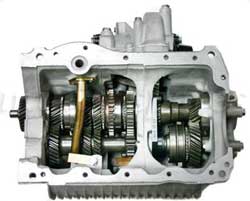
With the engine and new 5 speed transmission re-installed in the vehicle, the new gear selector parts must be fitted before re-connecting the gear selector extension shaft. The new selector parts can be assembled without removing the gearchange remote from the vehicle. It is recommended that the gear lever be removed.... Read more
Your 5 speed gearbox has a special 5th gear, laygear, and reverse idler shaft assembled with a modified gearbox main case and a different speedo end casting.
These parts must be removed before the main gearbox cluster can be removed. When a clean work area has been prepared, the removal of the 5th gear and laygear is as follows.
1. Remove the new speedo end casting assembly with the two bearings. These are a slide fit in the casting and are not positively retained.
2. Remove taper bearing No LM11749 off the 5th gear shaft along with the needle roller bearing carrier from the bore of the 5th gear, leaving the gear loose on the shaft.
3. Remove diff and housing as per workshop manual, turn the selector rod at base of diff housing area anti clockwise-and with the spool pull out as far as possible... Read more
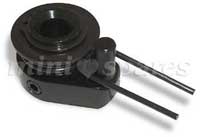
The bias barrel was originally developed as part of our five speed gearbox package, necessary to facilitate accurate gear selection and gear lever position.
It soon became apparent that this device would vastly improve the gear change on the standard four speed rod change gearbox, endowing Minis and Metros with the ‘modern car’ feel, and taking the quessology out of gear selection.
Read more
Contents:- Part Number Description Quantity
C-AEG578 Camshaft sprocket, lightened adjustable x 1
AEA695 Crankshaft sprocket x 1
2H4905 Timing chain x 1
AEA687 Screw - countersunk x 2
2A759 Locktab for cam gear x 1
The front plate will have to be countersunk as shown ’X’ to take the screws AEA687, which replace the existing hexagon-headed screws, which would foul on the timing chain. Check for clearance on chain all round and align gears as per Workshop Manual.
Read more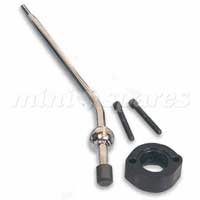
Remote Change
1. Remove original gearstick. Fit Quickstick with original plastic collar, spring and spring retainer, grease well and refit with new spacer. Place flange downwards using longer 5/16” UNC capscrews. Read more
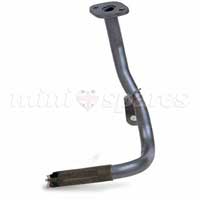
Oil pressure loss caused by oil surge can be experienced under hard cornering. To alleviate this it is essential to fit a centre oil pick-up pipe.Mini Spares' continual research and development program has seen advances in pick-up pipe design, replacing the original ancient design conceived by Abingdon ST some thirty-plus years ago. Read more
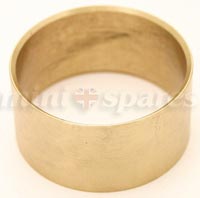
This bush is made to fit as many known 1275 primary gears - both helical and straight cut - as possible that use the original 22G109 type bush. There may be some exceptions where the manufacturer uses a slightly shallower bush housing Read more
A fairly crucial part of how the primary gear operates is its tolerances and running clearances. End float is a continual problem as folk either ignore it through ignorance or lack of accessible information on how to do it, or belief special tools are needed.
Terminology: DTI - Dial Test Indicator Also, later factory assembled engine units (from about 1992 onwards) were built up using whatever thrust washers were available, since Rover were not making regular orders for all shim/washer sizes due to the forthcoming end of production. Consequently, many units left Rover with incorrect (usually too big) clearances. The primary gear was no exception. Too much end float and clutch disengagement is adversely affected, the gear floating up and down the crankshaft in unison with the clutch plate. The result is a graunching gear change since the plate isn't clearing the flywheel and pressure plate surfaces fully. Too little end float and the gear is likely to be pinched tight as it gets hotter in operation. Read more
Although not of immediate interest to many road-runners/street-burners, mainly accorded to the racing scene, it seems to be a perplexing problem to a very large number of folk around the world, and has burned up plenty of telephone time. Distilling the myriad of 'the symptoms go like this' descriptions down from various languages it has been put to me in - the end result was always the same. The bushes at one end or other, and sometimes both, had failed in their duties. Incidentally - some of the confusion when trying to sort the problem descriptions was down to misunderstandings about which end of the primary gear is which. To put the record straight, the end nearest the engine is the FRONT end. Consequently the end nearest the flywheel is then the REAR end. The two biggest outstanding symptoms were severe oil leaks onto the flywheel/clutch assembly, and difficulty/impossibility in selecting gears. Read more
This is going to be REAL short!
There's only one. No choice in the matter as it comes attached to the diaphragm.
Game over.
Read moreCalculation for gear ratios and transmitted engine rpm Basic rule to remember is ratio is established by dividing tooth count on driven gear by the tooth count on its driver.
Basic rule to remember is ratio is established by dividing tooth count ondriven gear by the tooth count on its driver. To work out overall gearbox ratios you also have to establish the constant ratio.
Terminology -
FD - Final Drive (diff ratio)
Calculation for establishing vehicle speed for different final drives.
Formula : 60,000
FD (Final drive/diff ratio) x wheel rev per mile.
Contrary to popular mis-guidance, all BBUs will fit all four-syncro gearboxes. It was only the three-syncro boxes that varied in casting dimensions causing hassles where 1275s were applied to 850/998 gearbox casings.
Terminology -
BBU - Big Bore Unit (1275cc based engines)
SBU - Small Bore Unit (850/998/1098cc based units)
FD - Final Drive
NOTE: This information is largely for transplanting large-bore engine units into small-bore engined Minis. For further information on up-grading transfer (drop) gears, refer to relevant separate article.
Contrary to popular mis-guidance, all BBUs will fit all four-syncro gearboxes. It was only the three-syncro boxes that varied in casting dimensions causing hassles where 1275s were applied to 850/998 gearbox casings. Read more
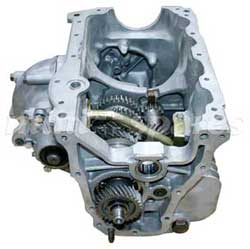
Having decided on or even implemented a course of action to bolster the performance of your Mini’s engine, maximising it’s potential should encompass a good look at the gearbox. Read more
Basic rule to remember is ratio is established by dividing tooth count ondriven gear by the tooth count on its driver. To work out overall gearbox ratios you also have to establish the constant ratio.
Terminology -
FD - Final Drive (diff ratio)
Calculation for establishing vehicle speed for different final drives.
Formula
These are for common tyre types, and accurate enough for assessment - a combination of using industry standard for theoretical calculation, actually measured assortment of wheels/tyres, and calculated averages! Applying Read more

